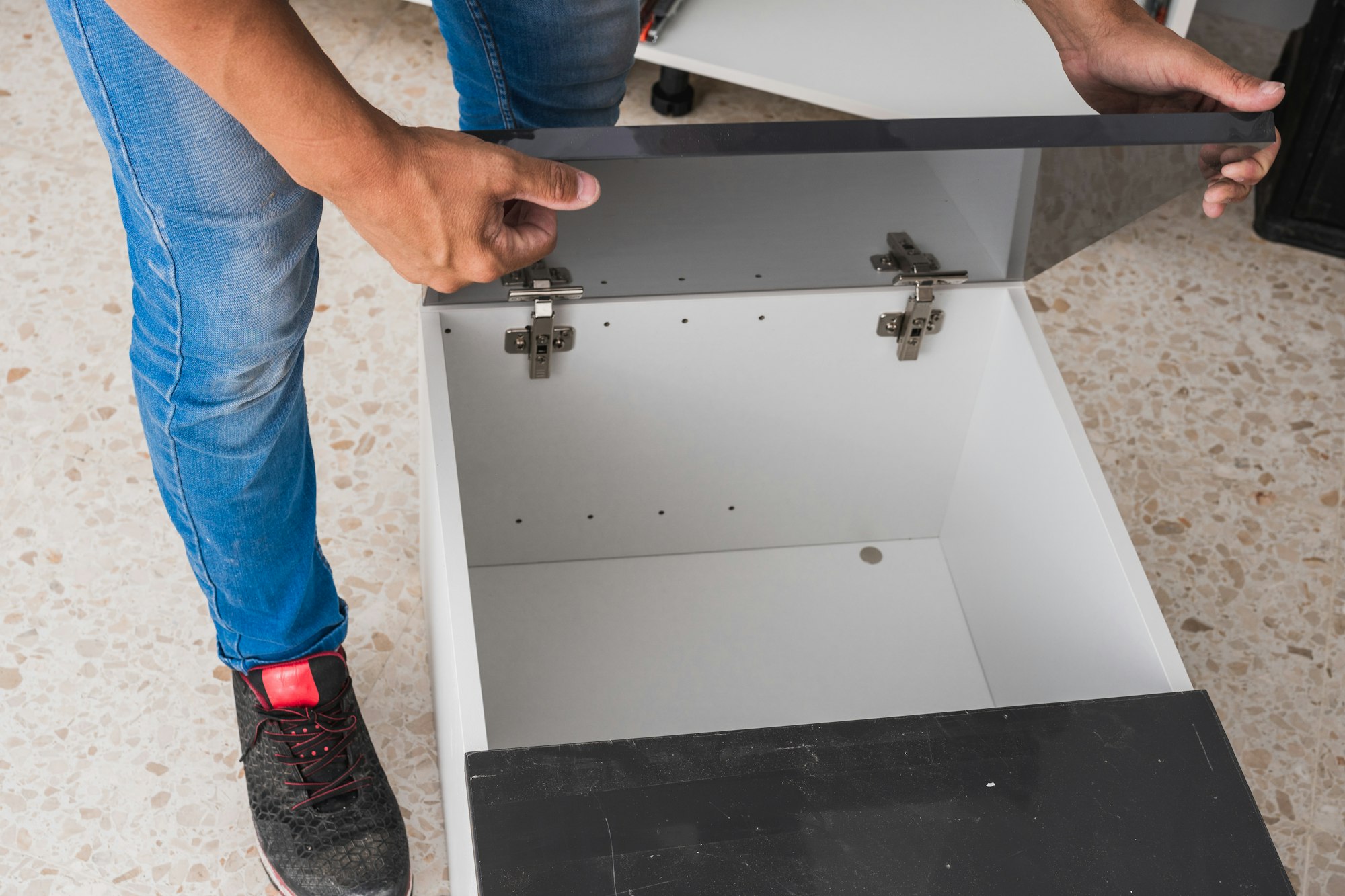Ultimate Guide on How to Install Base Cabinets at Home
Introduction
Installing base cabinets is an important part of building or remodeling a kitchen because they add to the look and provide storage space. For an expert look, whether you’re a beginner or a seasoned do-it-yourselfer, you need to know how to install base cabinets, especially on different surfaces and in different ways.
Tools and Materials Needed
Have the following tools and items ready before you start to fit:
- Tape measure
- Pencil
- Level
- Stud finder
- Drill and bits
- Screws
- Shims
- Clamps
- Carpenter’s square
- Construction adhesive
- Safety goggles and gloves
Preparation Steps
- Measure and Plan: Measure the space where the cabinets will be installed. Create a detailed plan, considering the layout and placement of each cabinet.
- Check Walls and Floors: Ensure the walls and floors are level. Use shims to correct any unevenness.
- Remove Existing Fixtures: If you’re replacing old cabinets, remove them carefully, making sure to disconnect any utilities.
Installing Base Cabinets
Locating and Marking Studs
- Find Studs: Use a stud finder to locate the studs in the wall. Mark their location with a pencil.
- Measure Heights: Measure and mark the height at which the top of the base cabinets will be installed.
Installing Base Cabinets without Studs
- Use Anchors: If studs are unavailable, use heavy-duty wall anchors to secure the cabinets.
- Apply Adhesive: For extra support, put construction glue on the back of the cabinets.
- Secure with Screws: Use screws to attach the cabinets to the wall anchors.
Installing Base Cabinets on Concrete
- Drill Pilot Holes: Drill small holes in the concrete floor with a brick bit.
- Insert Anchors: Insert concrete anchors into the drilled holes.
- Secure Cabinets: Position the cabinets and secure them to the floor using screws and the installed anchors.
Installing Base Cabinets for an Island
- Plan Layout: Mark the outline of the island on the floor.
- Install Blocking: Install blocking in the floor to provide a secure cabinet base.
- Attach Cabinets: Position the island cabinets and secure them to the blocking with screws.
Installing Kitchen Cabinets for Beginners
- Start with Corner Cabinets: Install the corner cabinets to establish a reference point.
- Use Clamps: Use clamps to hold cabinets together before securing them with screws.
- Level and Shim: Ensure each cabinet is level and shim as needed to maintain alignment.
Aligning and Securing Cabinets
- Check Alignment: Continuously check the alignment of the cabinets with a level.
- Secure Frames: Use screws to secure the cabinet frames to each other for a seamless look.
- Install Toe Kicks: Attach toe kicks to the bottom of the cabinets for a finished appearance.
Final Adjustments and Finishing Touches
- Install Doors and Drawers: Attach doors and drawers, ensuring they operate smoothly.
- Add Hardware: Install handles, knobs, and other hardware.
- Caulk and Seal: Apply caulk to seal gaps between the cabinets and walls.
Troubleshooting Common Issues
- Cabinets Not Level: Re-check measurements and use shims to correct any discrepancies.
- Doors Misaligned: Adjust the hinges to realign the doors.
- Gaps Between Cabinets: Use filler strips to close any gaps between cabinets.
Safety Tips and Precautions
- Wear Safety Gear: You should always wear safety glasses and gloves when installing.
- Use Proper Tools: Ensure you use the correct tools for each task.
- Handle Heavy Items with Care: Cabinets can be heavy, so use appropriate lifting techniques or seek assistance.
Maintenance and Care
- Regular Cleaning: Wipe cabinets with a damp cloth to remove dust and grime.
- Avoid Excessive Moisture: Keep cabinets dry to prevent warping or damage.
- Check for Loose Hardware: Periodically check and tighten any loose screws or hardware.
Frequently Asked Questions (FAQs)
How do I install base cabinets without studs?
Installing base cabinets without studs involves using heavy-duty wall anchors and construction adhesive to ensure the cabinets are securely attached to the wall.
Can I install base cabinets on a concrete floor?
Yes, you can install base cabinets on a concrete floor by drilling pilot holes, inserting concrete anchors, and securing the cabinets with screws.
What is the best way to install base cabinets for an island?
When installing base cabinets for an island, it’s important to plan the layout, install blocking for support, and securely attach the cabinets to the blocking.
How do beginners start installing kitchen cabinets?
Beginners should start by installing corner cabinets first, using clamps to hold cabinets together, and ensuring each cabinet is level before securing them with screws.
What should I do if my cabinets are not level?
If your cabinets are not level, re-check your measurements and use shims to adjust and correct the alignment.
Conclusion
Setting up base cabinets is a fun job that will greatly affect how your space looks and works. This conclusion details how important it is to install things correctly, make them look better, fix problems and make adjustments, think about safety, and finish your job.
Importance of Proper Installation:
Cabinets need to be installed correctly for them to last a long time and stay stable. Safely fixed cabinets prevent things from falling over and ensure they can handle the weight of daily use without sagging or moving. This also helps make your kitchen or laundry area safer as a whole.
Enhancing Aesthetic Appeal:
Beyond functionality, well-installed cabinets greatly enhance the visual appeal of your space. Level and aligned cabinets create a clean and seamless look in a kitchen, laundry room, or garage. Properly sealed gaps and smooth-operating doors and drawers elevate the overall aesthetics, making your home more inviting and valuable.
Troubleshooting and Adjustments:
Even with careful planning, adjustments may be necessary during installation. Shimming cabinets ensure they sit level on uneven floors while fine-tuning alignment ensures a cohesive appearance. Checking for level and ensuring secure anchoring are essential steps in troubleshooting installation challenges.
Safety Considerations:
Safety should always come first when putting shelves in. You should always wear safety glasses and gloves to keep yourself safe when working with tools and materials. Do what it says on the box of tools and equipment. If you’re stuck or don’t know what to do, someone could help you.
Finalizing Your Project:
Take some time to look over your work after the installation is done. Make sure that all cabinet doors and drawers open and close easily; if they don’t, fix the hinges. Fill in any holes between cabinets and walls with caulk for a nice look. Stand back and enjoy the difference that properly placed base cabinets make in your home, in terms of how it looks and works.
Ready to transform your kitchen? Visit contractorhomequotes.com now to get free quotes from top contractors and make your dream kitchen a reality!
Free Contractor Quotes: A Homeowner’s Guide to Smart Hiring
Get free contractor quotes to confidently plan your home project. Our guide explains how to compare quotes, avoid hidden costs, and hire the right pro for your budget.
Finding a Reliable 24 Hour Contractor Near You
Discover how to find and choose a reliable 24 hour contractor for home emergencies. Learn when to call, what to expect, and how quick action saves you time and money.
Understanding Your Plumbing Quote: A Homeowner’s Simple Guide
Confused by plumbing quotes? Our simple guide helps homeowners understand costs, compare estimates, and choose the right professional for lasting repairs.
Find a Pro!
"*" indicates required fields








